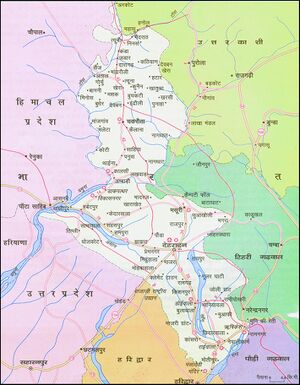Hanol
| Author:Laxman Burdak, IFS (R) |

Hanol (हनोल) is a village in Tyuni tehsil of Dehradun district in the state of Uttarakhand, India.
Origin
Hanol is derived from 'hanul' meaning fire.
Location
According to Census 2011 information the location code or village code of Hanol village is 044725. Hanol village is located in Tyuni Tehsil of Dehradun district in Uttarakhand, India. It is situated 15km away from sub-district headquarter Tyuni and 101km away from district headquarter Dehradun. As per 2009 stats, Chatra is the gram panchayat of Hanol village. The total geographical area of village is 35.55 hectares. Hanol has a total population of 180 peoples. There are about 39 houses in Hanol village. Chakrata is nearest town to Hanol which is approximately 13km away.[1]
History
Hanol has Mahasu Devta Temple dedicated to Lord Mahasu. Mahasu Devta is worshiped in the entire Jaunsar-Babar region and is at seven places across this region like Radina, Thaina, Indroli, Lakhwar, and Lakhamandal.
Hanol is derived from 'hanul' meaning fire. Before mahasu arrived, this place was used for torturing offenders with the heat of fire by putting them in the hollow of a big drum, placed horizontally and heated from below. Earlier the place was known as Chakrapur, and it is said to be the place to which the pandavas escaped from laksha graha or the Lakhmandal on River Yamuna. The village is at an altitude of 1,050 m above M.S.L. on the left bank of Tons River earlier known as River Tamas (meaning short-tempered). No water can be drawn from it for irrigation purposes, because of its precipitous banks and deep gorges. It is for this reason the river is called Karam Nashini. According to another tradition, the water of River Tons are the tears from the eyes of Bhubruvanan.
The temple village of Hanol is a sort of pilgrimage place for people living in vast areas in the mountainous parts of Uttarakhand, west of Yamuna River, The trans giri area of Sirmaur district and a major part of Shimla district of Himachal Pradesh.
Hanol is approachable from Tiuni, a well-known trijunction of roads on the Pabbar River after covering a distance of 15 km on an all-weather motorable road that meanders smoothly through the pine clad mountain slopes. Although the terrain through which the road passes is very narrow and by another side of the road one can see the river tons. Besides his ancient and principal temple at Hanol, Mahasu Devta has number of temples scattered in his deitydom.
Besides Hanol temples situated at villages namely Thaina, Basoi and Gabela are regarded as Thans (Abode) of Mahasu. Also the temples dedicated to Mahasu Devta birs (His two deputies) Kaulo and Shedkulia have exclusive temples for them in Tiuni and Raaigi.
There are many Mahasu Devta Temples in the whole Jaunsar-Bawar region, some famous of them are located at village Bisoi, Buraswa, Kotua, Laksiyar are in Uttrakhand and Nagheta in Sirmour HP. The number of temples of Mahasu and his brothers are situated at various places of Devghar, Jaunsar-Bawar and Sirmour areas.[2]
Mahasu Devta Temple
Mahasu Devta Temple (महासू देवता मंदिर,हनोल) is on the eastern bank of Tons River (Tamas) at Hanol village, near Chakrata, about 190 km from Dehradun, 156 km from Mussoorie and about 140 km from Shimla.
Mahasu Devta Temple or Masto Devta Temple, is located on the Tuini-Mori road at Hanol, Dehradun district, Uttarakhand, India. The temple is dedicated to Mahasu Devta. Lord Mahasu is the chief deity of this area and is worshipped in Mahasu Devta Temple by the people of Hanol and nearby villages of Uttarakhand and Himachal Pradesh state of India. It is the ancient temple of Mahasu Devta built in the 9th century. The temple was constructed in Kath-Kuni or Koti-Banal style of architecture.[3]It is included in the Archaeological Survey of India list of the ancient temple in the Dehradun circle, Uttarakhand.
External links
References
- ↑ https://villageinfo.in/uttarakhand/dehradun/tyuni/hanol.html
- ↑ mahasudevta mandir-lakshiyar
- ↑ Art & Architecture of Uttarakhand By Madhu Jain By - O. C. Handa

